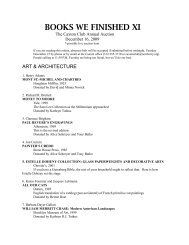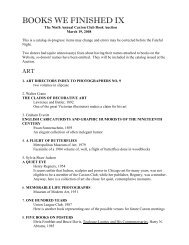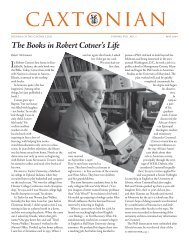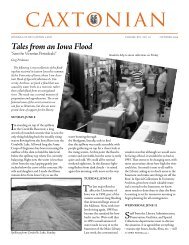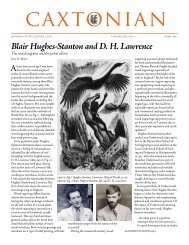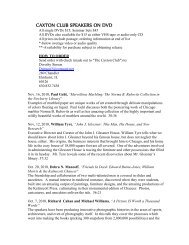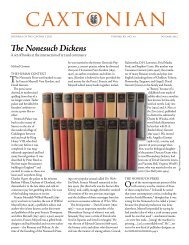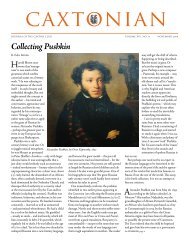Easter Egg Chickens - The Caxton Club
Easter Egg Chickens - The Caxton Club
Easter Egg Chickens - The Caxton Club
You also want an ePaper? Increase the reach of your titles
YUMPU automatically turns print PDFs into web optimized ePapers that Google loves.
EASTER EGG CHICKENS, from page 3<br />
that a magazine devoted to geography<br />
should also cover practically<br />
everything there is. In other words,<br />
as Grosvenor told the writer, when<br />
he came upon a subject he thought<br />
might interest the magazine’s<br />
readers, “I don’t scrutinize it to see if<br />
it’s geographical.”11<br />
That strategy, combined with<br />
the liberal use of illustrations, was<br />
wildly successful. At the time Grosvenor<br />
joined the Society’s staff, the<br />
magazine’s circulation was about<br />
1,400. Within five years, circulation<br />
topped 10,000. Ten years later, it<br />
was almost 300,000. By 1934, after<br />
Grosvenor had been at the helm for<br />
thirty-five years, circulation hovered<br />
near 1,000,000. Today, its monthly<br />
worldwide circulation is about<br />
8,500,000, almost half of which is<br />
outside the United States.<br />
Grosvenor’s success generated<br />
plenty of cash. As a not-for-profit<br />
educational institution, the Society<br />
had no shareholders and could not<br />
pay dividends. That is not to say it<br />
operated on a spartan budget. In<br />
1914, the Society built its own headquarters<br />
in Washington. <strong>The</strong> building<br />
had three private dining rooms, where the<br />
employees ate for free. One dining room was<br />
for men, another for women. <strong>The</strong> reason for<br />
segregating the sexes? As one Society executive<br />
told the New Yorker writer, it was so the<br />
men could feel at liberty to tell the occasional<br />
“risqué anecdote.”12<br />
<strong>The</strong> third dining room was Grosvenor’s<br />
private preserve, where he often ate alone.<br />
Nearby was Grosvenor’s private bathroom<br />
with two marble showers. During the hot<br />
Washington summers, he occasionally let<br />
senior staff members use them.<br />
One day, as we were working our way<br />
through the boxes of old Geographics<br />
in the Richmonds’ crawl space, Larry held<br />
up an issue and said, “Wow, look at this!” I<br />
assumed he had found a choice article on what<br />
Gilbert Grosvenor called “tribal women.” But<br />
I could hardly have been more wrong. “This<br />
is amazing,” Larry continued. “<strong>Chickens</strong> that<br />
lay colored eggs!” He handed me the September<br />
1948 issue. <strong>The</strong> article, by long-time<br />
staff writer Frederick G. Vosburgh, was titled<br />
“<strong>Easter</strong> <strong>Egg</strong> <strong>Chickens</strong>.” It told the story of one<br />
Ward Brower, Jr., who raised chickens that laid<br />
4 CAXTONIAN, AUGUST 2012<br />
<strong>The</strong> magazine arrived at its iconic look by the nineteen-teens.<br />
blue, pink, or green eggs.<br />
According to the article, Brower had himself<br />
been inspired by a long piece in the April<br />
1927 National Geographic titled “<strong>The</strong> Races of<br />
Domestic Fowl.” Among that article’s many<br />
illustrations was a color painting of three<br />
chickens at a nest containing bright blue eggs.<br />
<strong>The</strong> picture was captioned “Araucanas, natives<br />
of South America.” Its accompanying text<br />
stated that the breed had been discovered in<br />
1914 and was the only domesticated fowl that<br />
lays a blue-shelled egg. Brower immediately<br />
decided he must have some of those chickens.<br />
He was then about twenty-one. His father<br />
was a prominent lawyer of old New York<br />
Dutch descent, a member of the elite New<br />
York Holland Society and the Delta Upsilon<br />
fraternity, a group whose members included<br />
Supreme Court justices, senators, members<br />
of Congress, governors, Nobel Prize winners,<br />
corporate CEOs, and university presidents,<br />
not to mention editors of Time, the Saturday<br />
Evening Post, and the Reader’s Digest. In<br />
the 1920s, the Brower family moved upstate<br />
from their Riverside Drive apartment to a<br />
3,000-acre tract in Sullivan County, then a<br />
still-wild country full of bears, wildcats, diamondback<br />
rattlers, and copperheads. Some<br />
Native Americans remained in the<br />
region, which in 1779 had been<br />
the site of a fierce conflict between<br />
the colonial militia and victorious<br />
forces led by the Mohawk Chief<br />
Thayendanegea.13<br />
In Sullivan County, Ward Sr.<br />
kept a stable of thirty-three riding<br />
horses. At first, there was no<br />
electricity. Winter temperatures<br />
reached forty degrees below zero.<br />
Later the family moved to Monroe,<br />
in Orange County, where they<br />
were listed as residents of a home<br />
called “Shadowmere” in the New<br />
York Social Blue Book for 1930. By<br />
then, Ward Sr. had largely given<br />
up the practice of law and devoted<br />
himself to buying and selling real<br />
estate.<br />
Ward Jr., born in 1906, followed<br />
his father to Columbia University,<br />
but by then the family was land<br />
poor, and Ward Sr. had to take<br />
out a second mortgage on the<br />
family home to pay the tuition.<br />
That didn’t last long. Ward Jr. was<br />
interested in natural science, and<br />
he dropped out after his freshman<br />
year, having reached the decision<br />
that he didn’t want to be a lawyer.<br />
By the time he saw the 1927 National Geographic<br />
article, Brower had started a landscaping<br />
business in Monroe. Undoubtedly, he had<br />
a contrarian streak. His father liked to say,<br />
“You know what Ward considers a ‘welcome’<br />
sign? One that says ‘No Admittance.’ ”<br />
Brower found the 1927 National Geographic<br />
article electrifying. His first step in locating<br />
the magical chickens was to write the<br />
U.S. Department of Agriculture. <strong>The</strong>y told<br />
him there were no Araucanas to be found<br />
in the United States. With characteristic<br />
single-mindedness, he then searched through<br />
hundreds of poultry magazines and equipment<br />
catalogues for clues to these chickens’<br />
existence. One day he came across an advertisement<br />
featuring a letter from a breeder in<br />
Chile endorsing a brand of incubator. Brower<br />
wrote the man – who in the letter mysteriously<br />
signed himself “Juan Sierra Z.” – to find<br />
out whether he knew anyone in Chile with<br />
Araucanas to sell.<br />
A year and a half later, Brower got a reply.<br />
Señor Sierra said the birds were extremely<br />
rare, and he had spent months searching for<br />
a breeding pair in vain. Finally, he was able to<br />
find two females and one male. He was ready<br />
from http://chiricahuaskyislandrodeo.blogspot.com/2011/11/items-from-past.html



